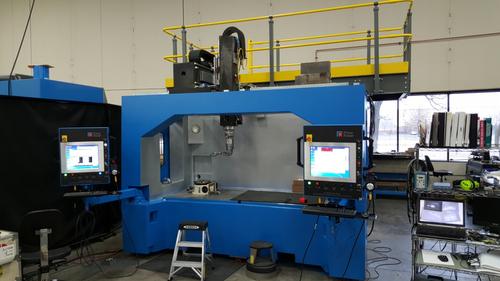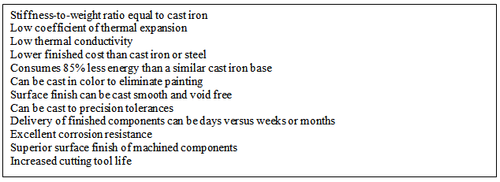For machine designers, primary machine structures typically mean cast iron or steel, but polymer composite castings can offer advantages, including lower cost and even improved machine performance.
February 22, 2016
For machine designers, primary machine structures need to provide predicable support to the machine components during use, resist distortion due to thermal transfer, withstand corrosion resistance to aggressive coolants, and maintain long-term stability. For machine tools, the ideal structure dampens vibration for improved cutting tool life, improved machined surface finishes on parts, greater positional accuracy at higher speeds. In the case of inspection equipment and pick-and-place machines, machine structure affects speed and location accuracy.

Laser machining center with 22,000 lb polymer composite casting with cast-in electrical cabinets.
(Source: Precision Polymer Casting)
Cast iron and steel are traditionally used for the manufacture of machine structures. Polymer composite castings can offer advantages to machine builders, including lower cost, cast to tolerance, and improved machine performance, such as vibration damping.
Polymer composite castings are a mixture of liquid resin, mineral aggregates, and additives that remove air voids and promote adhesion. The most common resin used in the US is bisphenol-A epoxy resin. Epoxy resin systems can be formulated to a low viscosity needed to provide easy blending with the aggregates, while providing excellent chemical resistance, high strength, and safe handling. Other resins used include urethane, phenolic epoxy, methyl methacrylate, furan, polyester, and vinyl esther. All of these offer advantages and disadvantages, but some concerns include higher cost, low flash points, highly corrosive VOCs, and uneven shrinkage during cure.

Polymer composites’ benefits for machine tool construction.
(Source: Precision Polymer Casting)
The most common aggregate used today is high-purity quartz. Crushed granite was used in the past, but it typically consisted of 85% quartz and 15% other stray minerals, such as feldspar and sandstone. These stray materials compromised strength and reacted chemically in an acidic environment. Crushed granite is also very jagged and does not compact well, leaving voids in the casting. Mechanical tests have shown that quartz filler has better strength versus crushed granite. Basalt can also be used but is neither readily available in graded sizes nor washed and dried.
Fillers can be altered to provide unique properties, such as industrial diamonds for surface wear resistance. Graphite can be added for lubrication, so a slide surface can be produced during the casting process. Crushed glass can be cast in, providing an inert encapsulation of a hazardous material.
READ MORE MATERIALS ARTICLES ON DESIGN NEWS:
Composite polymer castings are produced at room temperature, which allows PVC pipes, hydraulic lines, pneumatic lines, and electrical lines to be cast internally. Foam cores can be cast into the neutral axis to reduce weight, with no appreciable impact on the casting’s stiffness. Tapped holes can be created by casting in custom-designed threaded inserts.
If all casting surfaces are to be finished, then a secondary pour is needed. Castings can be cast in color, eliminating the need to paint. Polymer composite castings do not need to be stress relieved, and they develop 95% cure in 24 hours and therefore can be used within days of casting.
You May Also Like



